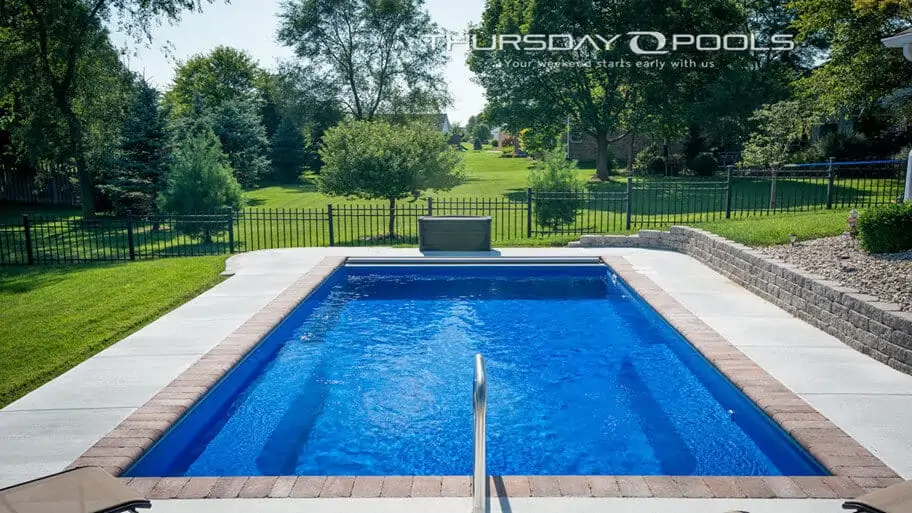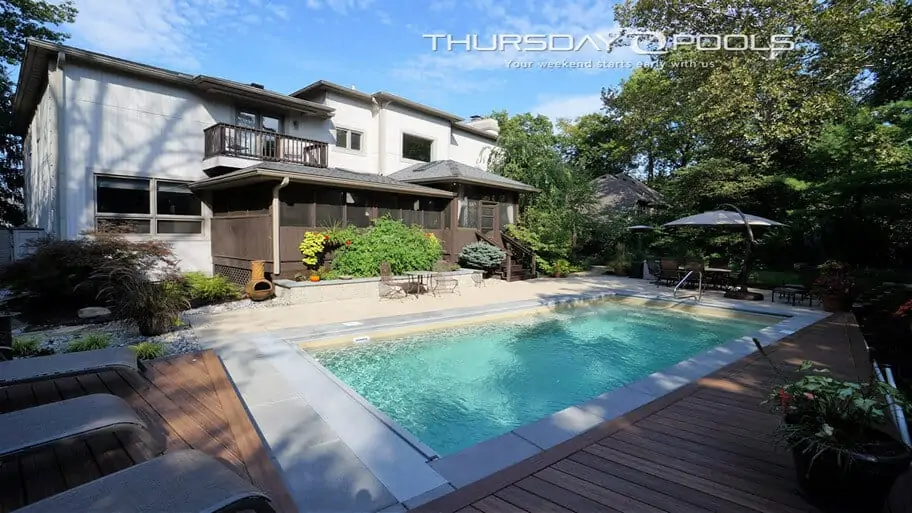As we’ve discussed in some of our other articles, vinyl liners need to be replaced every 4-9 years. Normal wear and tear takes its toll on a liner and a replacement liner is just something that comes along with owning a vinyl liner pool.
We replace liners every year and although it may sound like a simple task when we tell you we cut out the old liner, smooth out the surface of the pool, and apply a new liner, but it’s actually a complex process.
There are multiple steps that we take to ensure that the old liner is taken out and the new liner is applied correctly.
So, in this article we are going to break down the steps of replacing a liner to show you what actually goes into the process.
Step 1: Preparation
Before we even begin the process of replacing a liner, we need to make sure that we have a few consecutive days of clear weather. For example, if we schedule the beginning of the process on a Monday, we’ll need that day as well as Tuesday and Wednesday clear of any rain.
The reason we need clear weather is so rain water doesn’t fill the pool back up as we are draining it—such situation would obviously set us back and cause us to drain the pool repeatedly.
So, once we’ve determined when we’ll have clear weather, we can begin the process.
Step 2: Draining the Pool
Day one can sometimes be solely devoted to draining the pool. The reason for this is because once the pool is drained, we need to allow some time for any ground water beneath the pool to make its way to the surface.
Ground water is water that is present underground and can therefore seep towards the pool causing a liner to float.
If there is any ground water, we will need to drain it out of the pool.
Our end goal is to allow as much ground water to present itself as possible. This way, once most of the ground water has presented itself, any remaining ground water will seep towards the pool at a slower rate. Thus we can fill the pool before any ground water presents itself again.
If there is no ground water, we can carry on with the process the same day.
Step 3: Cut Out Old Liner
Once the pool is drained properly, we can begin cutting out the liner.
During this part of the process, we also take all of the faceplates out of the pool. And the nice thing about this is that we’ll put in brand new faceplates on the skimmer, returns and main drains every time a liner is replaced. We’ll also take out the pool light(s) at this stage in the process to be reinstalled when the new liner is in.
So by the end of the process, your pool will look brand new. And, keep in mind, this happens every 4-9 years so you’ll get a brand new-looking pool every time!
Step 4: Repairing the Surface
Once the liner is completely cut out, the surface of the pool will be exposed. Therefore, this is a perfect time for us to make any repairs necessary.
First, we’ll re-tape any seams on the wall where wall panels are fused together to ensure that they will continue to hold up and taping will allow the liner not to get sucked into the seams.
Then, we’ll spray down and brush all of the vermiculite flooring. Once it is clean, we will fill in any holes or gaps with new vermiculite to make the entire surface smooth.
One bag of vermiculite will be included in the repair contract that covers most standard pool repairs needed to keep your vinyl liner pool in working order.
Now, there are different materials used for flooring such as sand and concrete.
Sand can be used as flooring, but should only in areas that are surrounded by sand, such as plots of land that are on a beachfront.
Concrete can be used for flooring as well in areas except those surrounded by sand. However, concrete cracks easier and can be harder to repair, which is why we suggest vermiculite on all new pools.
The last thing we’ll do during this step is spray adhesive on the gaskets of the skimmer and main drain to keep them intact while hanging the liner.
Step 5: Hang New Liner
Liners are directional, meaning the manufacturer will tell us which way we will need to hang the liner. Example: Shallow to Deep or Deep to shallow etc.
In other words, they will tell us if we need to start at the deep end and work toward the shallow end or vice versa.
Most of the time we will start at the deep end and work toward the shallow end unless the pool has vinyl-over-steel steps—in which case we will start at the steps and work our way towards the deep end.
Step 6: Completion
Once the new liner is completely hung we will use a liner vacuum to suck the air out from underneath it. The purpose of using a liner can is to simulate the effect of water by sucking the liner into place. This allows us to walk around the liner (without shoes so it is not torn) to work out any wrinkles.
When the liner is completely vacuumed and in place, we will have to cut out the sections of vinyl where the main drain, skimmers and returns are located.
Once this is done, we can begin to fill the pool—but only to a certain distance. We will run the hose along the slope of the pool to the deep end and fill the pool about 6-8 inches into the shallow end. Or, to simplify it, we’ll fill the pool to so the water level is a little higher than an ankle-length in depth.
Once the pool is filled to this level, we will pull the liner vacuum out of the pool and tuck the rest of the liner into the wall. We can also finish cutting out the return jets and skimmer if they have not been done already, and put back the light(s).
And then we finish the job of filling the pool so your vinyl liner pool will look as good as new!
Recap
As you can see, the job is a little more intensive than just cutting out the old liner and putting in a new one!
We follow every step that you see above and make sure everything is done correctly since a liner is a delicate material.
Caution is key in this process since we don’t want to tear the new liner; it’s just as important to us as it is to you!
And like we said before, even though this is a cost that needs to be factored in every 4-9 years, the upside is that your pool essentially gets refurbished to look like a new pool each time!
So, we hope that this gave you a little more insight into the process of replacing a liner and if you want to read more about vinyl liner pools, check out the articles below!\






